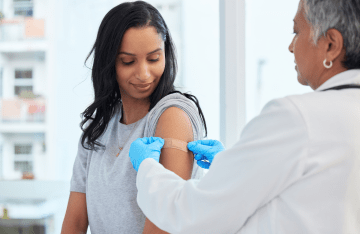Flu Vaccination Rate Holds Steady But Misinformation About Flu and Covid Persists
The latest Annenberg Science Knowledge survey examines attitudes, concerns, and existing knowledge of vaccines among adults in the United States.
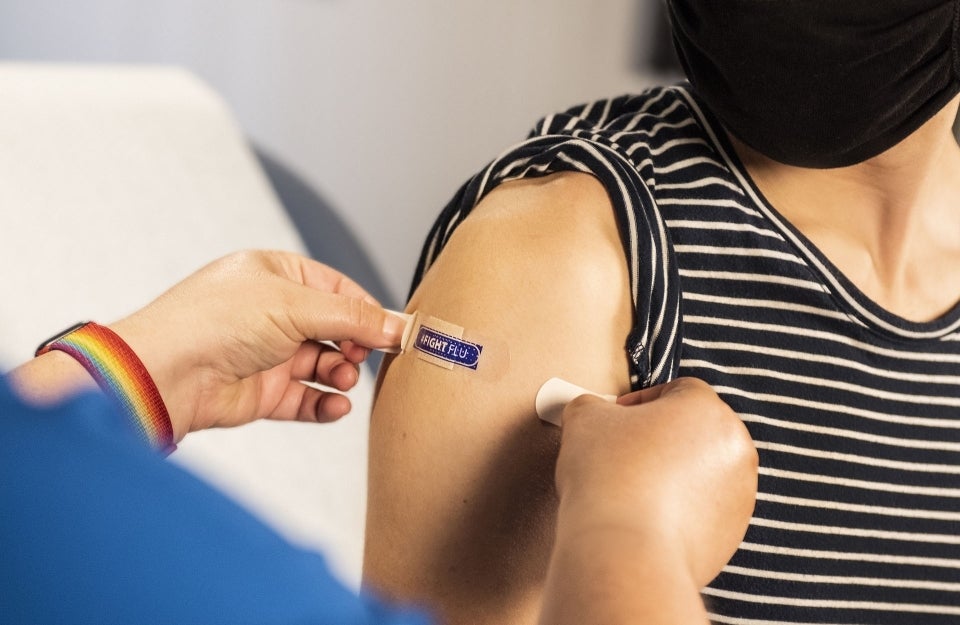
Photo Credit: CDC / Unsplash.
Although the public had been alerted that this winter could be a potentially bad flu season, barely half of Americans said in January that they had received a flu shot, a vaccination level unchanged in a representative national panel from the comparable period last year, according to the latest Annenberg Science Knowledge (ASK) survey by the Annenberg Public Policy Center of the University of Pennsylvania.
The panel survey, fielded with over 1,600 U.S. adults, finds that many have a base of knowledge about the flu but there is a reservoir of uncertainty about other consequential information about the flu, Covid-19, and vaccination. Among the findings of the ASK survey, which also inquired more broadly about attitudes toward vaccine mandates and the continuing “return to normal”:
- Nearly half of Americans (49%) do not know it is safe to get a flu shot during pregnancy.
- Over half of Americans (53%) say the Army should be able to require Covid-19 vaccination for soldiers who do not have a medical or religious exemption – and a plurality (45%) say public schools should be able to require Covid-19 vaccination of all children who do not have a medical or religious exemption.
- Only 10% of those who had heard of NFL player Damar Hamlin’s on-field collapse think that vaccination was connected to his cardiac arrest – but many more are not sure whether the rate of heart-related deaths has increased among young athletes over the past three years.
- More than half of Americans (52%) now say their lives have returned to a pre-pandemic normal, up significantly from 47% in October 2022.
- “Although the CDC indicated that seasonal flu activity is now low nationally, the fact that the level of reported flu vaccination in our panel was roughly the same in January of this year as a year before is concerning,” said Kathleen Hall Jamieson, director of the Annenberg Public Policy Center. “Because this has been a more severe flu season than the one a year ago, we expected an increase in the reported vaccination rate.”
The nationally representative panel of 1,657 U.S. adults surveyed by SSRS for the Annenberg Public Policy Center (APPC) of the University of Pennsylvania from January 10-16, 2023, was the tenth wave of an Annenberg Science Knowledge (ASK) survey whose respondents were first empaneled in April 2021. The margin of sampling error (MOE) is ± 3.2 percentage points at the 95% confidence level. See the Appendix and Methodology for question wording and additional information.
What the public knows: The flu and flu shot
The latest wave of the ASK survey finds that many people know the basics about the flu:
- Handwashing: 93% of respondents know that washing your hands helps you avoid getting sick from or spreading the seasonal flu.
- Getting the flu again: 83% know it’s possible to get the flu more than once in a flu season.
- Vaccine effectiveness: 77% know that the effectiveness of the seasonal flu shot in the United States can vary from year to year.
- However, 19% of respondents also think, incorrectly, that the effectiveness of the measles vaccine can vary from year to year and 40% are not sure.
- Nearly three-quarters of those surveyed (73%) think the seasonal flu shot is effective at reducing the risk of getting the flu this year.
- Mask-wearing: 77% know that wearing a high-quality, well-fitting mask helps limit the spread of flu.
- Contagion: 76% know it’s possible to spread the seasonal flu to others even if you have no symptoms.
- 14% of our respondents say they have had the flu this season. Of this group, 8% had no symptoms; 29% had mild symptoms; 43% had moderate symptoms; and 19% had severe symptoms.
A majority of the public knows that the following claims are false:
- Flu vaccine and Covid-19: Three-quarters (77%) know it’s false to say that the seasonal flu shot increases your risk of getting Covid-19 – though 6% incorrectly think this is true and 17% are not sure whether it is true or false. (See APPC’s project FactCheck.org to learn more about the false claim linking the flu shot and Covid-19.)
- Better late than never: 71% know it’s false to say that if you haven’t gotten your flu shot by November, there’s no value in getting it – though 11% incorrectly think this is true and 18% are not sure. (The CDC recommends vaccination even after November because significant flu activity can continue into May.)
- Cold weather: Nearly two-thirds (65%) know it’s false to say that cold weather causes the flu – but a third either incorrectly think this is true (22%) or are not sure (13%).
- The flu can be treated: 64% of respondents know it’s false to say there is no treatment for the flu – but 23% incorrectly think this is true and 13% are not sure if it is true.
Areas of uncertainty
But there are important claims about the flu that substantial parts of the public are confused about:
- Pregnancy: Almost half (49%) do not know that it is safe to get a flu shot during pregnancy, including the 10% who think it is not safe and 39% who are unsure. Just 51% know it is safe.
- Get flu from the shot? 46% do not know you cannot get the flu from the flu shot, including 29% who think you can get the flu from the shot and 16% who are not sure.
- Antibiotics and the flu: 45% do not know that the flu cannot be treated with antibiotics, including 25% who think it can be treated with antibiotics and 20% who are unsure.
- Antibiotics and viruses: 40% do not know that antibiotics do not work on viruses such as those that cause colds, the flu, and Covid-19 – including 20% who think it is false to say antibiotics don’t work on viruses, and 20% who are unsure.
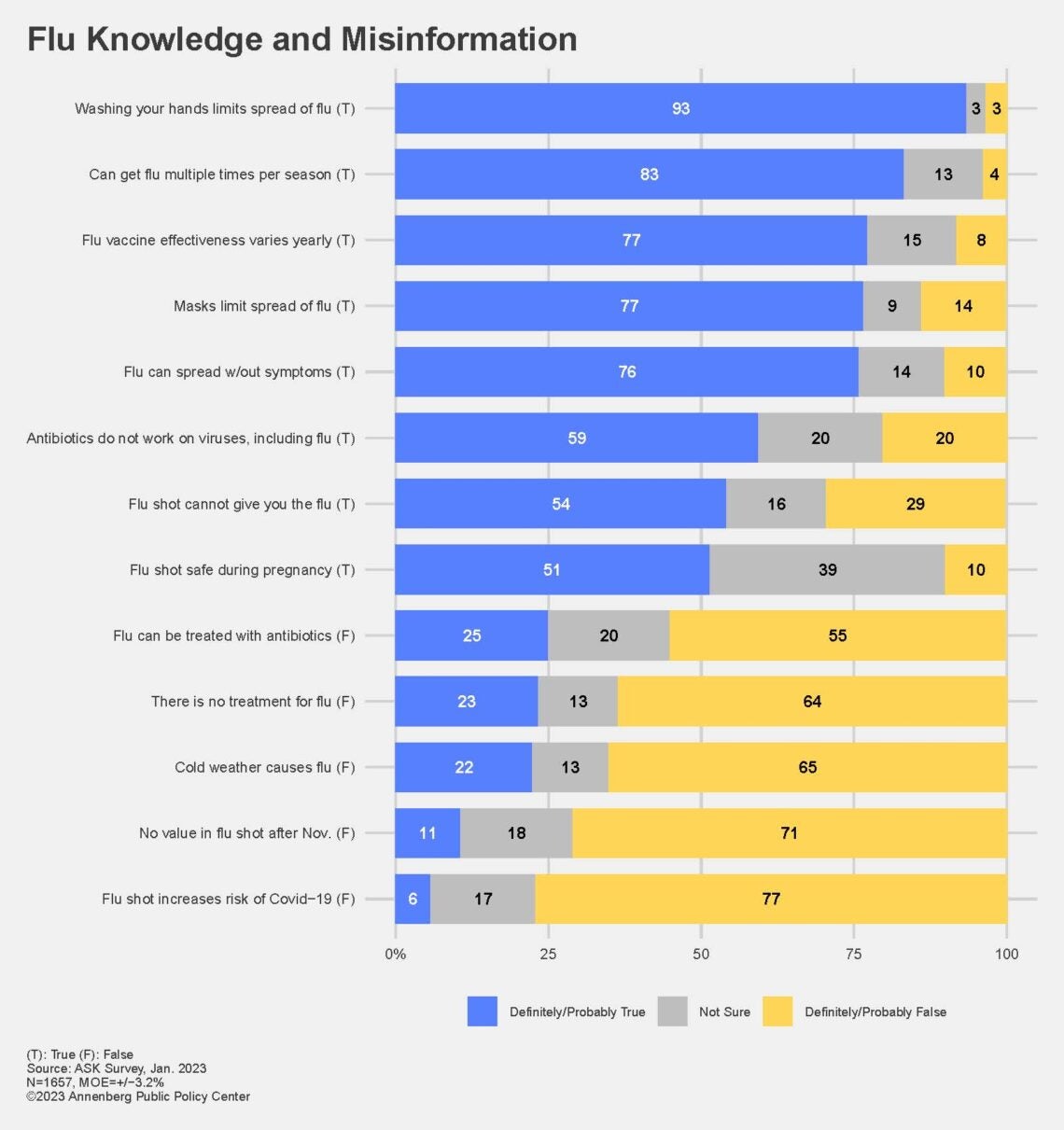
Attitudes toward flu vaccination
- Tamiflu: Nearly two-thirds of those surveyed (65%) disagree with the statement that there’s no need for a flu shot because they can always use Tamiflu to treat flu symptoms.
- Breakthrough infections: 58% disagree with the statement that breakthrough seasonal flu infections are evidence that flu shots don’t work – though 15% agree and 26% neither agree nor disagree.
- Danger to children: 57% disagree with the statement that children do not need the seasonal flu shot because they are at a low risk of death from the flu – though 18% agree and 25% neither agree nor disagree.
- Flu shots for all: Just 41% agree that every person older than six months should get a flu shot every year – 33% disagree and 26% neither agree nor disagree. The CDC recommends a flu shot every season for nearly everyone six months and older.
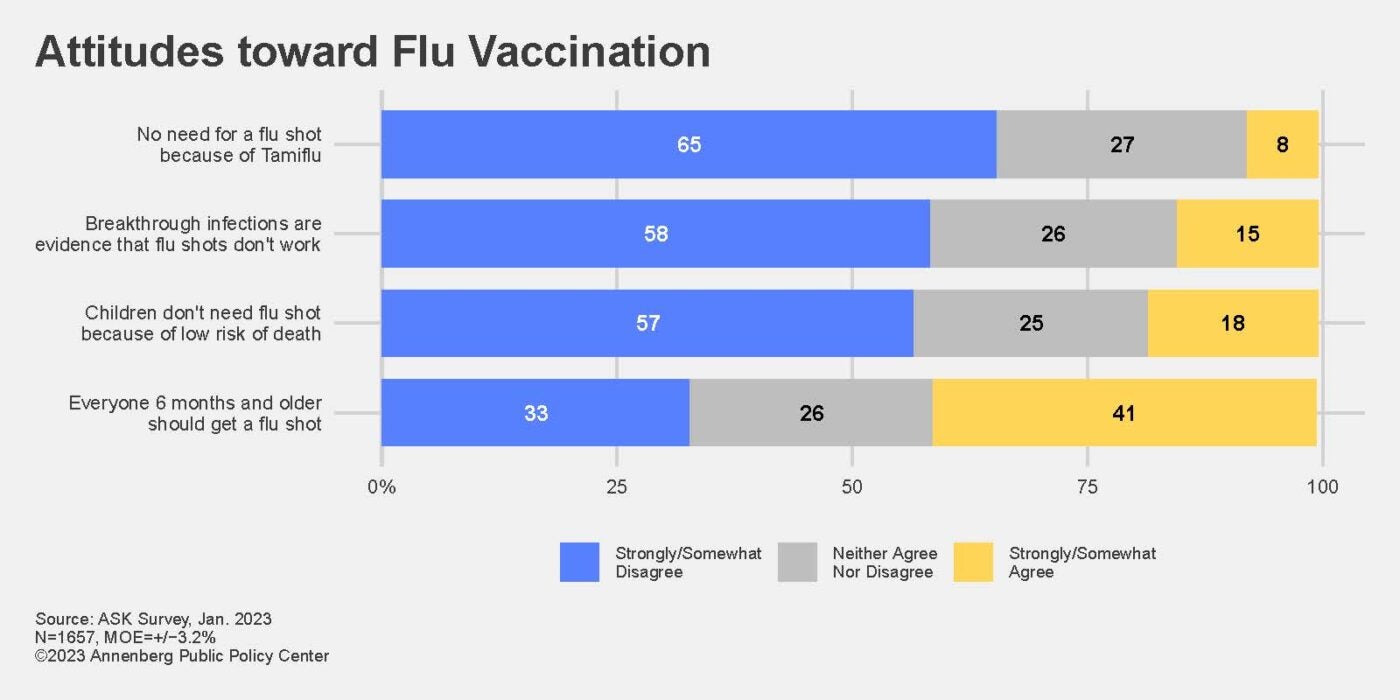
How many have had a flu shot – and why
The ASK survey in January 2023 finds that 49% of respondents say they have had a seasonal flu shot, statistically unchanged from 47% in our January 2022 survey and 50% in April 2021. According to the Centers for Disease Control and Prevention (CDC), nearly 46% of U.S. adults 18 and older had a flu shot as of December 31, 2022.
The CDC actively promoted flu vaccination amid concerns that the 2022-23 season would be severe.
When the 49% of survey respondents who said they got the flu vaccine were asked in January why they got the shot (multiple responses were permitted):
- 69% said I get it every year (down from 78% in January 2022)
- 64% said to protect myself against catching the flu (up from 44% in January 2022)
- 8% said to protect myself against Covid-19 (unchanged from 9% in January 2022)
- 25% said because it is recommended by the CDC (this response was not previously offered)
Concerns: The flu, Covid-19, RSV, polio, myocarditis
Worries about family members contracting flu, Covid, or RSV: About a third of those surveyed say they are somewhat or very worried about family members contracting Covid-19 (36%), the seasonal flu (35%), or RSV, respiratory syncytial virus (33%). Only 11% say they are somewhat/very worried about a family member contracting polio, which reemerged as a public health threat in July 2022 after a case was reported in New York State. (FactCheck.org has more about poliovirus being found in New York City sewage.)
Myocarditis: Rare cases of myocarditis, an inflammation of the heart muscle, have been reported among those who have had mRNA Covid-19 vaccines, particularly young males following a second vaccine dose. (FactCheck.org has more on the Covid-19 vaccine and myocarditis.) The connection between myocarditis and the vaccine has drawn attention on social media and in news media.
The survey found that over a third of respondents (37%) think that Covid-19 poses a higher risk for myocarditis than the vaccine against Covid-19. But 17% think that is false and nearly half of those surveyed (47%) are not sure which poses a higher risk.
Damar Hamlin and young athletes dying of heart problems
Much of the public rejects the notion that Damar Hamlin’s collapse during an NFL game had anything to do with the vaccine against Covid-19. But the survey finds that many people are uncertain about the broader unsupported claim that more young athletes are dying of heart problems these days.
Hamlin, a safety on the Buffalo Bills, suffered a cardiac arrest during the Jan. 2, 2023, game against the Cincinnati Bengals, triggering a spate of unfounded, anti-vaccine conspiracy theories on social media about the cause. The overwhelming majority of those in our survey (87%) said they had heard, read, or seen reports of his collapse.
But those respondents overwhelmingly reject the idea that a Covid-19 vaccine caused Hamlin’s injury. Only 10% of those who had heard of the incident attribute it to factors connected with the vaccine. Nearly half (49%) say that based on what they had heard of it, Hamlin’s cardiac arrest was most likely caused by being hit hard in the chest; 17% say an underlying heart condition; and 21% say they are not sure. (FactCheck.org writes about what was known about Hamlin’s injury.)
While social media posts with millions of views quickly associated Hamlin’s collapse with vaccination, mainstream media sources noted the lack of evidence for such claims or dismissed them as misinformation. See, for example, stories such as The inevitable, grotesque effort to blame vaccines for Damar Hamlin’s collapse (Washington Post, Jan. 3) and Hamlin’s collapse spurs new wave of vaccine misinformation (Associated Press, Jan. 5).
However, 26% of those surveyed say they think that the number of young athletes dying of heart problems increased over the past three years, and nearly half (49%) are not sure whether the number has increased or decreased. Only 23% say that the numbers of deaths have remained virtually unchanged. (See FactCheck.org’s article No Surge in Athlete Deaths, Contrary to Widespread Anti-Vaccine Claims on why this claim is unfounded.)
Covid-19 and MMR vaccine mandates
Schools and military: The ASK survey finds stronger support for a Covid-19 vaccine mandate in the military than in public schools, with over half supporting a military mandate:
- 53% of those surveyed strongly or somewhat agree that the U.S. Army should be able to require Covid-19 vaccination of all soldiers who do not have a medical or religious exemption and 30% strongly or somewhat disagree (asked of a survey half-sample).
- 45% strongly or somewhat agree that public schools should be able to require Covid-19 vaccination of all children who do not have a medical or religious exemption and 38% strongly or somewhat disagree (asked of a half-sample).
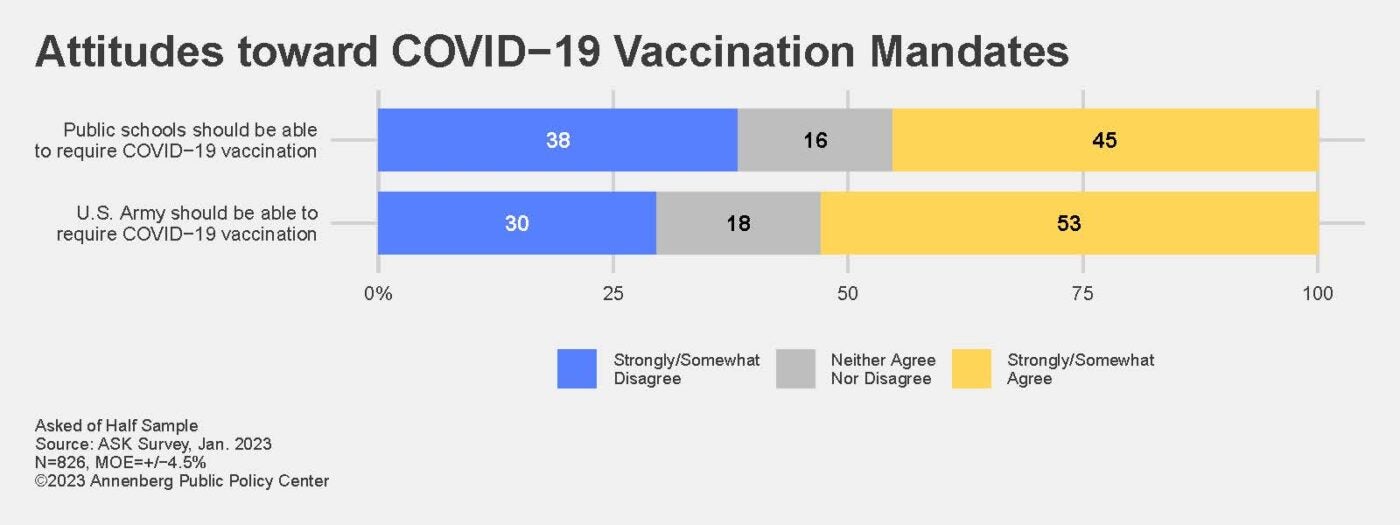
MMR vaccine: Asked their views on the childhood vaccines for measles, mumps, and rubella (MMR), 63% agree that healthy children should be required to get the MMR vaccine in order to attend public schools, while 22% say parents should be able to decide whether to vaccinate their children who attend public schools and 15% are not sure.
Getting back to ‘normal’
The return to normal: Asked when they expect to be able to return to “your normal, pre-Covid-19 life,” more than half of Americans (52%) say they already have – up from 47% in October 2022. More than 1 in 5 Americans (22%) continue to say “never,” which is statistically unchanged since July 2022.
Mask-wearing: Six in 10 people (61%) say they never or rarely wear masks, statistically unchanged from the 60% who said this in October 2022. And 18% say they always or often wear a mask, also statistically unchanged from the 17% who said so in October.
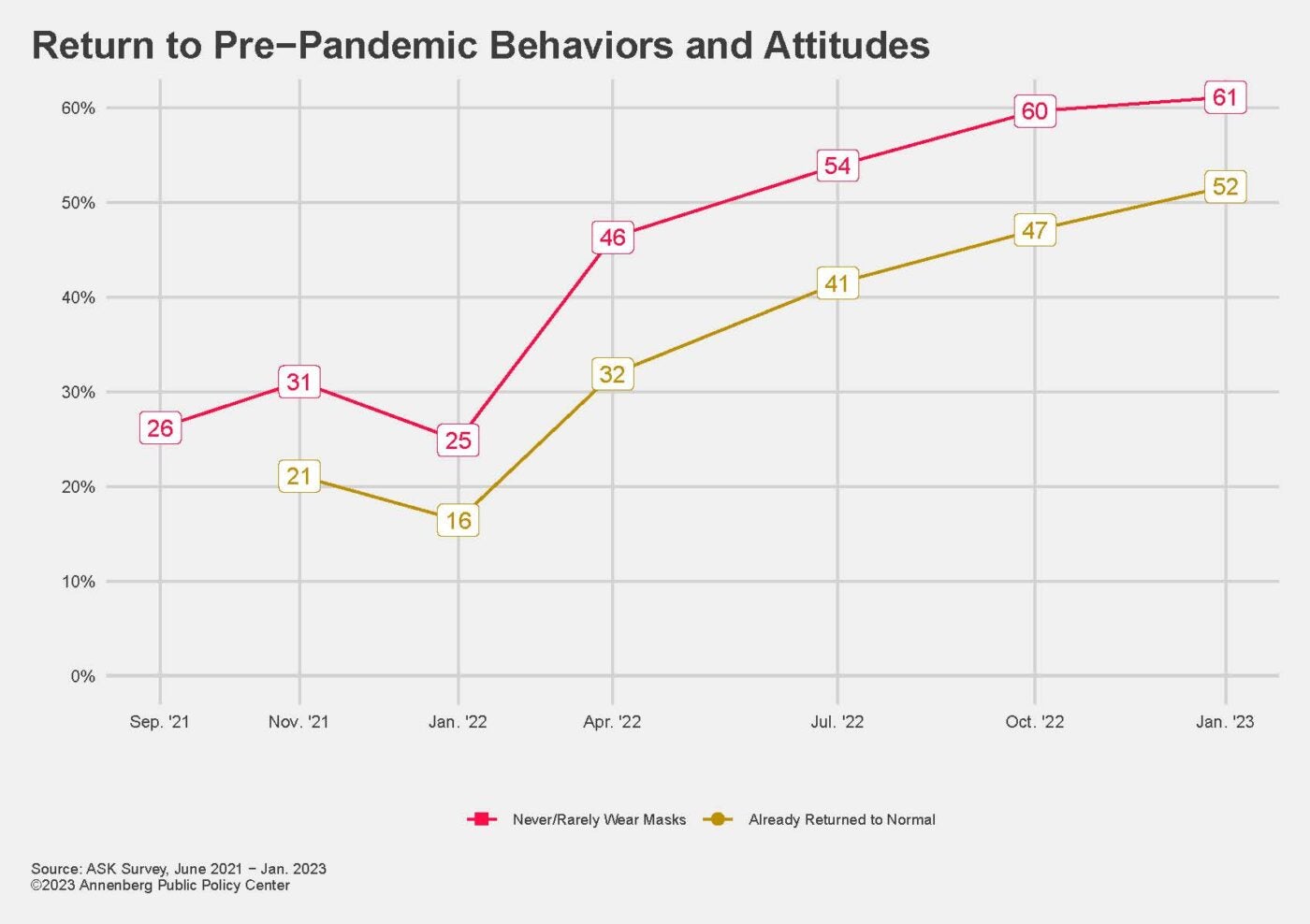
See the Appendix for question wording and data and the Methodology for additional information. Read about prior Annenberg Science Knowledge surveys.



